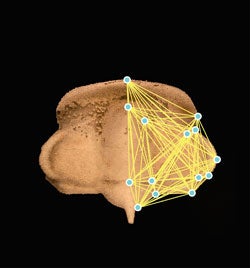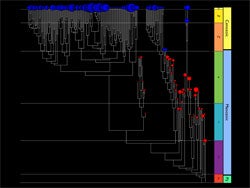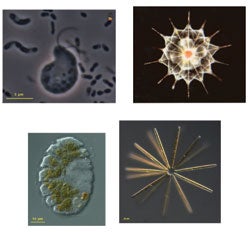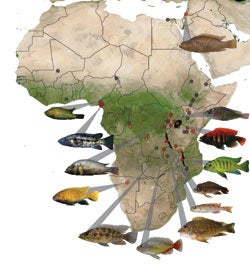Keynote Speakers
 Douglas H. Erwin
Douglas H. Erwin
Senior Scientist and Curator of Paleobiology, National Museum of Natural History, The Smithsonian Institution
Changing dynamics in macroevolution
The term macroevolution encompasses four logically and empirically distinct explanatory schemes for large-scale patterns in the fossil record:  1) the persistence of microevolutionary processes over long time periods, the default position adopted by Simpson and other participants in the modern synthesis; 2) alternative modes for generating variation; 3) differential sorting, and possibly selection, between species and clades to generate evolutionary trends and other patterns; and 4) changes in the evolutionary process itself over time, creating the potential for new forms of biological organization and ecological structure. I will focus on recent comparative studies of the evolution of development which suggest that some macroevolutionary changes may involve differences in the sources of variation (option 2) and be non-uniformitarian (option 4), associated with the structuring of developmental gene regulatory networks. Documenting the circumstances and consequences of different macroevolutionary modes remains a significant challenge for paleobiologists.
1) the persistence of microevolutionary processes over long time periods, the default position adopted by Simpson and other participants in the modern synthesis; 2) alternative modes for generating variation; 3) differential sorting, and possibly selection, between species and clades to generate evolutionary trends and other patterns; and 4) changes in the evolutionary process itself over time, creating the potential for new forms of biological organization and ecological structure. I will focus on recent comparative studies of the evolution of development which suggest that some macroevolutionary changes may involve differences in the sources of variation (option 2) and be non-uniformitarian (option 4), associated with the structuring of developmental gene regulatory networks. Documenting the circumstances and consequences of different macroevolutionary modes remains a significant challenge for paleobiologists.

Robert E. Ricklefs
Curators’ Professor of Biology, Department of Biology, University of Missouri at St. Louis
My half century with the taxon cycle
E. O. Wilson’s idea that the geographic distributions of species undergo cycles of expansion and contraction has, itself, gone through cycles of acceptance and rejection that mirror how ecologists have considered the historical and geographic contexts of local ecological systems.  The taxon cycle concept highlights the tension between extrinsic and intrinsic drivers of species distributions and patterns of biodiversity. Its history concept sheds light on contemporary issues in ecology and evolutionary biology and offers some resolution of the underlying causes of patterns of diversity and abundance.
The taxon cycle concept highlights the tension between extrinsic and intrinsic drivers of species distributions and patterns of biodiversity. Its history concept sheds light on contemporary issues in ecology and evolutionary biology and offers some resolution of the underlying causes of patterns of diversity and abundance.
Photo credit: Richard Shirley
Presenters
 Paul Harnik
Paul Harnik
Postdoctoral Fellow, National Evolutionary Synthesis Center
Macroevolutionary consequences of rarity in the marine fossil record
Rarity is the primary criterion used to predict extinction risk today and has been implicated as an important factor in numerous biodiversity crises in the geologic past. Species can be rare in markedly different ways and the relative importance of these different forms of rarity in macroevolution cannot be disentangled until their effects are examined simultaneously.  Here I examine the direct and indirect effects of multiple forms of rarity on extinction in the marine fossil record and show how macroevolutionary inference changes after accounting for covariation among different forms of rarity. Focusing first on the early Cenozoic history of marine bivalves, I compare a set of models relating abundance, body size, and geographic range size to species duration and test the generality of these models across three ecologically-disparate clades. Expanding the scope of investigation, I then consider the associations between rarity and extinction risk globally over the past 500 million years using data for more than 6000 marine invertebrate genera. Together these analyses reveal systematic differences in macroevolutionary outcome among different forms of rarity throughout the evolutionary history of marine animal life and provide support for general rules governing extinction and survival over deep time.
Here I examine the direct and indirect effects of multiple forms of rarity on extinction in the marine fossil record and show how macroevolutionary inference changes after accounting for covariation among different forms of rarity. Focusing first on the early Cenozoic history of marine bivalves, I compare a set of models relating abundance, body size, and geographic range size to species duration and test the generality of these models across three ecologically-disparate clades. Expanding the scope of investigation, I then consider the associations between rarity and extinction risk globally over the past 500 million years using data for more than 6000 marine invertebrate genera. Together these analyses reveal systematic differences in macroevolutionary outcome among different forms of rarity throughout the evolutionary history of marine animal life and provide support for general rules governing extinction and survival over deep time.
Photo credit: Paul Harnik
 Melanie Hopkins
Melanie Hopkins
Postdoctoral Researcher, University of Erlangen-Nuremberg
Traits, species, and evolutionary modes
How do species evolve and at what rates? Is most change concentrated at speciation events or does it occur gradually along branches? What is the relative frequency of different modes of evolution? New methods are being developed to better address these fundamental questions, but most studies examine individual size and shape traits, implicitly assuming that single phenotypic traits are adequate representations of species-level change.  However, because of varying integration within and among parts, trait evolution may be better understood if studied at multiple hierarchical levels. Furthermore, there is considerable variation in evolutionary mode amongst traits within individual lineages. This past year, my colleagues and I were the first to document this variation in mode across disparate taxonomic groups and using a consistent analytical protocol. Our results argue strongly for the pervasiveness of mosaic evolution. This conclusion is further supported by recent work from others showing variation in rates of trait evolution within phylogenies. What remains understudied is trait change in the context of species-level geographic variation. Thus, a major challenge for future research on the evolution of species will be to combine a modularity-based quantification of morphology with detailed geographic sampling.
However, because of varying integration within and among parts, trait evolution may be better understood if studied at multiple hierarchical levels. Furthermore, there is considerable variation in evolutionary mode amongst traits within individual lineages. This past year, my colleagues and I were the first to document this variation in mode across disparate taxonomic groups and using a consistent analytical protocol. Our results argue strongly for the pervasiveness of mosaic evolution. This conclusion is further supported by recent work from others showing variation in rates of trait evolution within phylogenies. What remains understudied is trait change in the context of species-level geographic variation. Thus, a major challenge for future research on the evolution of species will be to combine a modularity-based quantification of morphology with detailed geographic sampling.
 Andrew Leslie
Andrew Leslie
Postdoctoral Research Associate, Yale School of Forestry and Environmental Studies, Yale University
Function, diversification, and macroevolutionary patterns in seed plants
My research explores the relationships between form and function in plants and asks how these interactions influence the evolution of morphology over million-year time scales. I use an integrative approach that incorporates techniques from paleontology, biomechanics, and phylogenetic methods, with an emphasis on linking results from studies of modern plants with data from the fossil record.  Within this framework, I will discuss specific projects exploring the functional relationships between cone morphology, pollen morphology, and pollination mechanism in many extinct and living seed plant groups, as well as the effect of increases in seed predation and animal-mediated seed dispersal during the Mesozoic on morphological diversity in conifers. I will also discuss a recently developed time-calibrated phylogenetic framework for living conifers that can be used to explicitly test a variety of large-scale patterns of character evolution. By synthesizing data from living and extinct plants, this work creates new opportunities for understanding and interpreting the evolution of seed plant reproductive structures, and in a broader sense, it highlights the important role that the paleobotanical record can play in understanding the drivers of morphological evolution within large-scale temporal, macroecological, and phylogenetic contexts.
Within this framework, I will discuss specific projects exploring the functional relationships between cone morphology, pollen morphology, and pollination mechanism in many extinct and living seed plant groups, as well as the effect of increases in seed predation and animal-mediated seed dispersal during the Mesozoic on morphological diversity in conifers. I will also discuss a recently developed time-calibrated phylogenetic framework for living conifers that can be used to explicitly test a variety of large-scale patterns of character evolution. By synthesizing data from living and extinct plants, this work creates new opportunities for understanding and interpreting the evolution of seed plant reproductive structures, and in a broader sense, it highlights the important role that the paleobotanical record can play in understanding the drivers of morphological evolution within large-scale temporal, macroecological, and phylogenetic contexts.
 Prashant Sharma
Prashant Sharma
National Science Foundation Postdoctoral Research Fellow in Biology, American Museum of Natural History
How fossils and model organisms inform early arthropod diversification: phylogeny and evolutionary development of Chelicerata
Recent fortuitous discoveries of fossils have begun to fill major gaps in understanding diversification of some of the earliest terrestrial animals: the Chelicerata, the division of arthropods that includes spiders, scorpions, and horseshoe crabs. Paleontological data can both guide and benefit from developmental model systems for discovery of genetic mechanisms whereby morphology is diversified. Here I present multiple studies of an emerging model system: Phalangium opilio, the common daddy-long-legs (order Opiliones). Together with existing chelicerate models, I integrate fossils with developmental techniques, demonstrating how genetic manipulation of a laboratory organism informs the reconstruction of chelicerate evolutionary history. First, I examine the trend of reduction in cheliceral articles in fossil and extant chelicerates, revealing the genetic mechanism for this transformation. Second, I present Hastocularius argus, a fossil species of Opiliones with two pairs of eyes, in contrast to extant species’ single pair. I examine neurogenetic gene expression in extant chelicerates, demonstrating that the organization of the Opiliones brain is developmentally similar to groups that bear multiple pairs of eyes (spiders and scorpions), rather than groups with a single pair (mites). Integrating paleontological, phylogenetic, and embryological approaches demonstrates that H. argus is a stem-Opiliones, a result with immediate implications for downstream analyses.
Together with existing chelicerate models, I integrate fossils with developmental techniques, demonstrating how genetic manipulation of a laboratory organism informs the reconstruction of chelicerate evolutionary history. First, I examine the trend of reduction in cheliceral articles in fossil and extant chelicerates, revealing the genetic mechanism for this transformation. Second, I present Hastocularius argus, a fossil species of Opiliones with two pairs of eyes, in contrast to extant species’ single pair. I examine neurogenetic gene expression in extant chelicerates, demonstrating that the organization of the Opiliones brain is developmentally similar to groups that bear multiple pairs of eyes (spiders and scorpions), rather than groups with a single pair (mites). Integrating paleontological, phylogenetic, and embryological approaches demonstrates that H. argus is a stem-Opiliones, a result with immediate implications for downstream analyses.
 Graham Slater
Graham Slater
Peter Buck Postdoctoral Fellow, Department of Paleobiology, National Museum of Natural History, The Smithsonian Institution
Tempo and mode in phenotypic evolution? The case of mammalian body size evolution
Historically, questions regarding tempo and mode of phenotypic evolution have been the domain of paleobiologists. In recent years, however, evolutionary biologists have become increasingly interested in addressing these questions using phylogenetic comparative methods. These approaches often make two assumptions; that data from extant taxa alone are sufficient to infer macroevolutionary process, and that variation in rates of phenotypic evolution, either through time or along branches, can explain observed patterns of morphological disparity.  Here, I address these assumptions using the case of body size evolution in Mesozoic and Cenozoic mammals. I show that addition of fossil taxa dramatically alters the best-fitting model of evolution. However, addition of candidate models that allow process, rather than just rates, to vary over the tree result in strong preference of constrained body size evolution during the Mesozoic and unconstrained evolution in the Cenozoic. Results further indicate that interpretation of evolutionary rates is dependent on the process under which the traits evolved. Tempo is inextricably linked to mode in macroevolution, and further integration of neontological and paleontological data are necessary to understand the dynamics of both.
Here, I address these assumptions using the case of body size evolution in Mesozoic and Cenozoic mammals. I show that addition of fossil taxa dramatically alters the best-fitting model of evolution. However, addition of candidate models that allow process, rather than just rates, to vary over the tree result in strong preference of constrained body size evolution during the Mesozoic and unconstrained evolution in the Cenozoic. Results further indicate that interpretation of evolutionary rates is dependent on the process under which the traits evolved. Tempo is inextricably linked to mode in macroevolution, and further integration of neontological and paleontological data are necessary to understand the dynamics of both.
 Laura Wegener Parfrey
Laura Wegener Parfrey
Postdoctoral Research Associate, University of Colorado at Boulder
Elucidating the evolutionary history of eukaryotes and complex eukaryotic traits
Microbial lineages make up the breadth of eukaryotic diversity and broad sampling of these lineages is essential to understanding the early history of the eukaryotic domain. Taking a taxon-rich approach enabled me to resolve the eukaryotic tree of life and revealed that the majority of 70+ eukaryotic lineages fall into just a few major clades.  The diversity of lineages included there also enabled me to take advantage of the rich fossil record of microbial eukaryotes in molecular clock analyses estimating the age of extant eukaryotes. I found that the last common ancestor of extant eukaryotes lived between 1866 and 1679 million years ago (Ma), with all of the major clades of eukaryotes emerging prior to 1000 Ma, a conclusion robust to varying the software platform, the position of the root, and the inclusion of Proterozoic fossils. These dates are broadly consistent with the fossil record, and support the emerging macroevolutionary paradigm of long stems that precede diversification across the major lineages of eukaryotes. My research continues to use the eukaryotic tree of life as a framework for elucidating the research evolutionary history of complex eukaryotic traits that define eukaryotes, such as meiotic sex, multicellularity, and genome dynamics.
The diversity of lineages included there also enabled me to take advantage of the rich fossil record of microbial eukaryotes in molecular clock analyses estimating the age of extant eukaryotes. I found that the last common ancestor of extant eukaryotes lived between 1866 and 1679 million years ago (Ma), with all of the major clades of eukaryotes emerging prior to 1000 Ma, a conclusion robust to varying the software platform, the position of the root, and the inclusion of Proterozoic fossils. These dates are broadly consistent with the fossil record, and support the emerging macroevolutionary paradigm of long stems that precede diversification across the major lineages of eukaryotes. My research continues to use the eukaryotic tree of life as a framework for elucidating the research evolutionary history of complex eukaryotic traits that define eukaryotes, such as meiotic sex, multicellularity, and genome dynamics.
Photo credit: Systematic Biology 2010 cover (cropped) and micro*scope
 Catherine Wagner
Catherine Wagner
Postdoctoral Research Associate, Eawag, Swiss Federal Institute of Aquatic Science and Technology and the University of Bern, Switzerland
Macroevolutionary patterns in cichlid fish adaptive radiation
A fundamental challenge to our understanding of biodiversity is to explain why some groups of species undergo adaptive radiations, diversifying extensively into many and varied species, while others do not. Both extrinsic environmental factors (e.g. resource availability, climate) and intrinsic lineage-specific traits (e.g. morphological traits, genetic architecture) influence diversification, but few studies have addressed how such factors interact.  Radiations of cichlid fishes in Africa provide some of the most dramatic cases of species diversification. However, most cichlid lineages in African lakes have not undergone adaptive radiation. To investigate when adaptive radiation occurs and what predicts the species richness of radiations, we compiled data on cichlid colonization and diversification in 46 African lakes, along with lake environmental features and information about the traits of colonizing cichlid lineages. We find that environmental factors, including lake depth and incident solar radiation, and a trait, sexual dichromatism, both strongly influence whether cichlids radiate. In addition, the richness of individual cichlid radiations is limited, but not well predicted, by ecosystem size and energy. Thus for cichlids, the coincidence between ecological opportunity and sexual selection best predicts whether adaptive radiation will occur, and ecosystem size and energy appear to limit the richness that these radiations reach.
Radiations of cichlid fishes in Africa provide some of the most dramatic cases of species diversification. However, most cichlid lineages in African lakes have not undergone adaptive radiation. To investigate when adaptive radiation occurs and what predicts the species richness of radiations, we compiled data on cichlid colonization and diversification in 46 African lakes, along with lake environmental features and information about the traits of colonizing cichlid lineages. We find that environmental factors, including lake depth and incident solar radiation, and a trait, sexual dichromatism, both strongly influence whether cichlids radiate. In addition, the richness of individual cichlid radiations is limited, but not well predicted, by ecosystem size and energy. Thus for cichlids, the coincidence between ecological opportunity and sexual selection best predicts whether adaptive radiation will occur, and ecosystem size and energy appear to limit the richness that these radiations reach.


